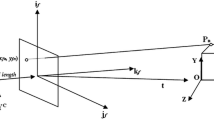Abstract
A method is described which recovers the 3-D shape of deformable objects, particularly human motions, from mobile stereo images. In the proposed technique, camera calibration is not required when taking images. Existing optical 3-D modeling systems must employ calibrated cameras that are set at fixed positions. This inevitably puts constraints on the range of the movement of an object. In the proposed method, multiple mobile cameras take images of a deformable object moving freely, and its 3-D model is reconstructed from the video image streams obtained. The advantages of the proposed method include the fact that the cameras employed are calibration-free, and that the image-taking cameras can move freely. The theory is described, and the performance is shown by an experiment on 3-D human motion modeling in an outdoor environment. The accuracy of the 3-D model obtained is evaluated and a discussion is given.
Similar content being viewed by others
References
JK Tan S Ishikawa (2001) ArticleTitleHuman motion recovery by factorization based on a spatio-temporal measurement matrix Comput Vision Image Understanding 82 101–109 Occurrence Handle1010.68556 Occurrence Handle10.1006/cviu.2001.0904
JK Tan S Ishikawa (2001) ArticleTitleRecovering 3-D motion of team sports employing uncalibrated video cameras IEICE Trans Inf Syst E84-D 1728–1732
C Tomasi T Kanade (1992) ArticleTitleShape and motion from image streams under orthography: a factorization method Int J Comput Vision 9 137–154 Occurrence Handle10.1007/BF00129684
Tabusa T, Tan JK, Ishikawa S (2002) Recovering human motions by mobile video cameras and factorization. Proceedings of the Asian Conference on Computer Vision, CD-R
Tan JK, Yamaguchi I, Tabusa T, et al. (2004) Various image-taking strategies for 3-D object modeling based on multiple cameras. Proceedings of the International Conference on Image Processing, pp 2487–2490
R Deriche Z Zhang Q-T Luong et al. (1994) ArticleTitleRobust recovery of the epipolar geometry for an uncalibrated stereo rig Lecture Notes on Computer Science, Computer Vision-ECCV 800 567–576
Author information
Authors and Affiliations
Corresponding author
Additional information
This work was presented in part at the 10th International Symposium on Artificial Life and Robotics, Oita, Japan, February 4–6, 2005
About this article
Cite this article
Tan, J., Ishikawa, S., Yamaguchi, I. et al. 3-D recovery of human motion by mobile stereo cameras. Artif Life Robotics 10, 64–68 (2006). https://doi.org/10.1007/s10015-005-0364-6
Received:
Accepted:
Issue Date:
DOI: https://doi.org/10.1007/s10015-005-0364-6




